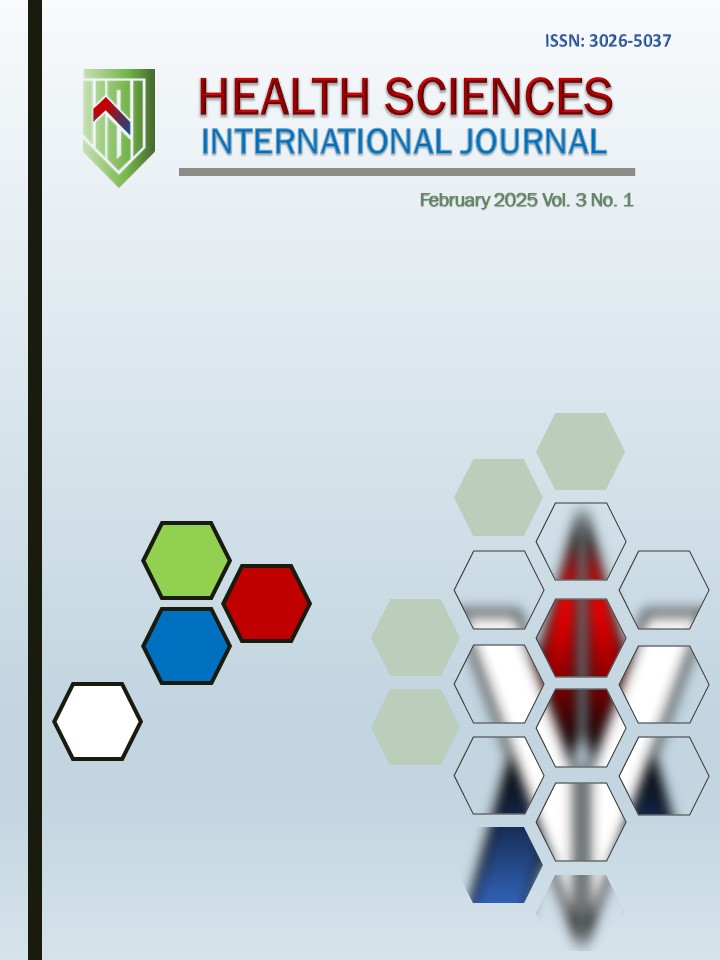Husband support, compliance in consuming Fe tablets and incident of anemia in pregnant women
DOI:
https://doi.org/10.71357/hsij.v3i1.58Keywords:
Husband’s support, Pregnant women , Compliace, Fe Tablets, Insidence of anemiaAbstract
Background: Anemia in pregnancy, particularly iron deficiency anemia, is a major public health concern with significant maternal and fetal implications. In Indonesia, anemia prevalence among pregnant women remains high, largely influenced by insufficient iron supplementation compliance and limited support systems. Husband support has been identified as a critical factor influencing maternal health behaviors, including compliance with consuming iron (Fe) tablets.
Objective: This study aims to analyze the relationship between husband support, compliance in consuming Fe tablets, and the incidence of anemia among pregnant women.
Method: A cross-sectional study was conducted involving 33 third-trimester pregnant women selected through purposive sampling. Data were collected using a validated questionnaire to assess husband support and maternal compliance with Fe tablet consumption. Hemoglobin levels were extracted from maternal health records. Statistical analysis included univariate and bivariate tests using the Fisher Exact Test and Chi-Square Test.
Result: The study found significant relationships between husband support and anemia (p = 0.035) and between compliance with Fe tablet consumption and anemia (p < 0.001). Pregnant women with good husband support were less likely to experience anemia (6.1%) compared to those with poor support (18.2%). Similarly, none of the compliant participants developed anemia, while 24.2% of non-compliant women were anemic.
Conclusion: Husband support and compliance with Fe tablet consumption are key factors in reducing anemia among pregnant women. Interventions should focus on enhancing spousal involvement and promoting adherence to iron supplementation to improve maternal and fetal health outcomes.
Downloads
References
Alfarisi, R., Hutasuhut, A. F., Kurniawan, B., & Taufiq, S. A. H. (2022). Relationship between parity and nutritional status of mothers during pregnancy with birth weight at Ratna Sari Dewi Midwife Clinic, South Jakarta [in Indonesia]. MAHESA : Malahayati Health Student Journal, 2(2), 380–389. https://doi.org/10.33024/mahesa.v2i2.4521
Darmawati, D., Kiftia, M., & Fitri, A. (2023). Husband's support with iron deficiency anemia in postpartum mothers [in Indonesia]. Cakradonya Dental Journal, 12(2), 104–110. https://doi.org/10.24815/cdj.v12i2.18441
Fajria, N. A., Sugesti, R., & Dewi, M. K. (2024). the relationship between physical activity, diet, and husband's support on the incidence of anemia in pregnant women in the Independent Practice of Midwife Irna Dewi [in Indonesia]. Jurnal Penelitian Inovatif, 4(2), 565–574. https://doi.org/10.54082/jupin.358
Gοugοutsi, V., Pouliakis, A., Argyrios, T., Tolia, M., Nazos, N.-A., Panagopoulos, P., & Kokoris, S. (2024). The Critical Role of the Early Evaluation of Iron and Vitamin B12 Deficiency in Pregnancy. Cureus. https://doi.org/10.7759/cureus.67592
Imaduddin, A., & Firdausi, M. (2023). The term “Husband as head of family and wife as housewife” in the marriage law and compilation of islamic law from a feminist perspective [in Indonesia]. The Indonesian Journal of Islamic Law and Civil Law, 4(2), 156–168. https://doi.org/10.51675/jaksya.v4i2.576
Jie, W., Zhenyu, Y., Xuehong, P., Yifan, D., Ye, B., Shan, J., & Jianqiang, L. (2022). Effects of parity on nutrition and health status of Chinese women of childbearing age. 中华预防医学杂志, 56(07), 966–972.
Kuntari, T., & Supadmi, S. (2024). Anemia in young pregnant women: A cross-sectional study in Indonesia. Jurnal Kedokteran Dan Kesehatan Indonesia, 147–161. https://doi.org/10.20885/JKKI.Vol15.Iss2.art3
Lao, T. T. (2024). The roles of blood picture, haemoglobinopathy traits, and blood groups determined in routine antenatal tests in the screening for complications in pregnancy. Best Practice & Research Clinical Obstetrics & Gynaecology, 97, 102537. https://doi.org/10.1016/j.bpobgyn.2024.102537
Mandey, C. P., Kundre, R., & Bataha, Y. (2020). Husband support with wife readiness: Cross sectional study at manado women and child hospital [in Indonesia]. Jurnal Keperawatan, 8(1), 51. https://doi.org/10.35790/jkp.v8i1.28411
Marley, A., & Brookes, M. J. (2024). Iron deficiency anaemia – modern investigation and management. Medicine, 52(2), 77–80. https://doi.org/10.1016/j.mpmed.2023.11.008
Milman, N., Kirchhoff, M., & Jørgensen, T. (1993). Iron levels in 1359 Danish women in relation to menstruation, use of oral contraceptives and parity. Ugeskrift for Læger (Ugeskr Laeger), 155(45), 3661–3665.
Mir, T. H. (2023). Adherence versus compliance. HCA Healthcare Journal of Medicine, 4(2). https://doi.org/10.36518/2689-0216.1513
Omasti, N. K. K., Marhaeni, G. A., & Dwi Mahayati, N. M. (2022). The relationship between compliance with iron tablet consumption and the incidence of anemia at Klungkung II Health Center [in Indonesia]. Jurnal Ilmiah Kebidanan (The Journal Of Midwifery), 10(1), 80–85. https://doi.org/10.33992/jik.v10i1.1636
Palimbo, A., Bamegawati, I. M., Mahdiyah, D., Herawati, A., Rahman, L. H., Fariana, Y. R. N., & Arfiah. (2024). Overcoming anemia in prospective brides and grooms as an effort to prevent stunting. Health Sciences International Journal, 2(2), 115-122. https://hsij.anandafound.com/journal/article/view/28
Putra, A. S., & Sulastri, D. (2024). Nutritional status and anemia in pregnant women: A systematic review. Malahayati International Journal of Nursing and Health Science, 7(5), 589–597. https://doi.org/10.33024/minh.v7i5.493
Shapiro, V., & Brosnan, H. (2023). Anemia. In A. Abd-Elsayed (Ed.), Advanced Anesthesia Review (pp. 447-C170.S13). Oxford University PressNew York. https://doi.org/10.1093/med/9780197584521.003.0169
Sukma, D. R., & Sari, R. D. P. (2020). The influence of pregnant mother's age factor on the type of delivery at DR. H. Abdul Moeloek Regional Hospital, Lampung Province [in Indonesia]. Majority, 9(2).
Swastika, S. (2024). Risk factors for anemia in pregnant women in the third trimester. International Journal of Advanced Health Science and Technology, 4(3). https://doi.org/10.35882/ijahst.v4i3.354
Tejavat, Dr. S. (2023). Prevalence of anemia: A comprehensive review. International Journal of Clinical and Diagnostic Pathology, 6(3), 88–97. https://doi.org/10.33545/pathol.2023.v6.i3b.539
Wylde, S., Nwose, E., & Bwititi, P. (2016). Morning sickness in pregnancy: Mini review of possible causes with proposal for monitoring by diagnostic methods. International Journal of Reproduction, Contraception, Obstetrics and Gynecology, 261–267. https://doi.org/10.18203/2320-1770.ijrcog20160356
Downloads
Published
Issue
Section
License
Copyright (c) 2025 Rizka Novia Rhamadayanti , Adriana, Latifah, Umi Hanik Fetriyah

This work is licensed under a Creative Commons Attribution-ShareAlike 4.0 International License.
Health Sciences International Journal (HSIJ) © 2023 by Ananda Health and Education Foundation is licensed under Attribution-ShareAlike 4.0 International







